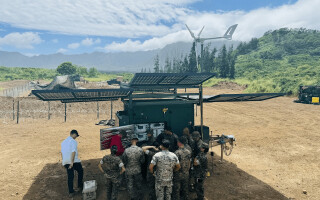Military platforms often last for decades, long past the life spans of modern computing components and boards. System designers for these aging platforms must rely on a variety of solutions from lifetime buys of components when they go end of life to working with aftermarket suppliers, who buy obsolete product lines and keep producing them for customers with ultra long-term needs. In this podcast with Ethan Plotkin, CEO of GDCA, we discuss military aftermarket trends, open architectures, artificial intelligence, and how sustainment reform can help solve long-term obsolescence challenges get in defense applications.
Military Embedded Systems
Podcasts
PODCAST: RF signal chain, military space market, and MOSA in space - Podcast
April 24, 2025The demand for high-reliability RF components in military space applications is growing as is the use of commercial innovation in Low-Earth Orbit and other space domains, says Eliot Fine, Product Line Manager for Space and High Reliability Components, Analog Devices. In this podcast he and I discuss the space electronic market, radiation-hardening techniques, as well as the Department of Defense’s (DoD’s) modular open system approach (MOSA) mandate and how it impacts space systems. Eliot also details the RF signal chain, a concept developed by his team at Analog Devices.
PODCAST: Sensor processing at the edge, being SOSA aligned, and DoD acquisition process - Podcast
May 28, 2024How artificial intelligence (AI) at the edge is defined often depends who you are speaking with and their market. For military electronics I think the best definition comes from Jake Braegelmann, Vice President of Business Development at New Wave Design, who says the edge is where the sensor collects the data and AI can enable the filtering of that data in real-time to get actionable intelligence to decision makers. In this podcast he and I discuss that concept in depth as well as the Department of Defense’s (DoD’s) modular open system approach (MOSA) mandate. Jake talks about what it means to be aligned to the Sensor Open Systems Architecture (SOSA) Technical Standard and dives into some common misconceptions about the standard.
PODCAST: Recruiting women engineers, military RF & microwave design trends - Podcast
January 25, 2024The defense technology community has a recruitment challenge on its hands when it comes to competing with the commercial technology world for engineering talent; this reality is especially true when it comes to growing the pool of women engineers. In this podcast with Maria Ho, Deputy Director for Government and Strategic Programs, Aerospace & Defense at Analog Devices, we discuss how to encourage female students to explore engineering careers, the importance of STEM in schools, and the ways in which Analog Devices invests in young engineers. Maria also talks about those people who have inspired her in her career and how popular culture can help inspire learners.
PODCAST: Metamaterial radar systems, COTS components, and RF invisibility cloaks - Podcast
November 29, 2023Leveraging metamaterials for radar designs, engineers at Echodyne are enhancing the capability of small radars for applications such a counter-UAS [uncrewed aircraft systems] in military applications. In this podcast with Tom Driscoll, Co-founder and CTO of Echodyne, he and I discuss how his team’s metamaterials electronically scanned array (MESA) radar system does thing that traditional active electronically scanned array (AESA) radar systems cannot, their unique business model, and how they leverage commercial-off-shelf (COT) components like Xilinx FPGAs.
MOSA, AI, and unsafe programming languages - Podcast
July 27, 2023Modular open system approach (MOSA) strategies such as the Future Airborne Capability Environment (FACE) Technical Standard are changing how the Department of Defense acquires technology. In this podcast with Tim Reed, Chief Executive Officer for Lynx Software Technologies, he and I discuss how MOSA benefits the warfighter and what it means to be certified conformant other the FACE Technical Standard.
Space electronics trends, supply chain challenges, MOSA, and more - Podcast
March 30, 2023Rebranded after being bought by Veritas Capital from CAES, Frontgrade Technologies is now a stand-alone company focused on the space market - military and commercial. In this podcast, Frontgrade President and Chief Executive Officer Mike Elias discusses how the acquisition and rebranding impacts the company and its clientele.
Defense supply chain issues, COTS procurement, MOSA, and more - Podcast
July 28, 2022The procurement challenges facing defense technology companies range from a slow U.S. Department of Defense (DoD) acquisition process to supply chain headaches to when and where to leverage commercial off-the-shelf (COTS) technology and open architectures.
Unmanned
NIC4 Awarded Satellite Communications Service Provider Registry Prototype Contract for the U.S. Space Force - Podcast
May 03, 2022TAMPA, FLORIDA ─ NIC4, a subsidiary of Network Innovations, announces that it has been awarded a Service Provider Registry (SPR) prototype, a component of the Satellite Communications (SATCOM) Enterprise Management and Control (EM&C). This software development effort is for the U.S. Space Force (USSF), Space Systems Command (SSC) through the Space Enterprise Consortium (SpEC) as an Other Transactional Authority (OTA) Agreement Award. The SPR prototype represents the company’s fourth major award under the EM&C program.
Military 5G designs, SATCOM on the move, ISR networks - Podcast
March 30, 2022Defense integrators are starting to adopt 5G technology for satellite communications (SATCOM) on the move applications through various programs aimed at deploying commercial innovations more quickly to warfighters.
Semiconductor supply chain, radar & electronic warfare designs, engineering talent - Podcast
January 31, 2022Complex radar and electronic warfare systems drive innovation from RF and microwave designers while supply chain shortages continue to give them headaches. In this podcast, Bryan Goldstein, VP, Aerospace and Defense, Analog Devices, tackles these trends while also exploring how the defense industry will begin adopting 5G technology and where it will likely deploy first. He also shares his passion for recruiting young engineering talent into the defense electronics industry through Science, Technology, Engineering, and Mathematics (STEM) programs and other unique internship and recruiting methods.
The current state of military hypersonic programs - Podcast
January 06, 2022Hypersonic weapons and the role they will play in modern warfare are evolving rapidly. The U.S. Navy's Conventional Prompt Strike program and the U.S. Army's Long-Range Hypersonic Weapon program are leading the charge for hypersonic advancements, and adversarial hypersonic developments are inspiring embedded electronics manufacturers to build defense and detection systems designed to better protect the home front. In the fourth episode of On the Radar, Emma Helfrich and John McHale discuss the concept of the hypersonic weapon and its history with the Department of Defense as it stands entering the new year. Also mentioned are additionally notable programs on the forefront of hypersonic weapon and detection innovation including both Defense Advanced Research Projects Agency (DARPA) and Georgia Institute of Technology-led strategies. Helfrich and McHale go on to outline funding projections, explain China's hypersonic test launch that occurred in August 2021, and try and break down congressional critiques of these MACH 5 missiles.
PODCAST: Delivering semiconductor supply chain integrity through industry partnerships - Podcast
December 03, 2021Experts from Mercury Systems and Micron Technology sat down to discuss how they deliver memory products with semiconductor supply chain integrity in the Mercury Now Podcast, titled Delivering semiconductor supply chain integrity through industry partnerships.
Microelectronics for space, and supply chain bottlenecks - Podcast
October 22, 2021Supply chain bottlenecks, small satellites, complex adversarial threats in space and electromagnetic spectrum domains are all driving innovation at the microelectronics level. In this podcast, Dave Young, CTO of CAES, formerly Cobham, discusses how these challenges impact microelectronics solutions for military programs, how the defense industry is coping with the semiconductor supply chain headaches through investment and a plan for on-shore production, how commercial-off-the-shelf (COTS) products factor into modern military space systems, and what CAES' acquisition of Colorado Engineering means for the company.
Cyber defense, tackling the climate crisis, and defunding platforms outlined in FY 2022 defense budget request - Podcast
October 22, 2021As the second and final installment of the On the Radar series covering the release of the Department of Defense (DoD) official budget request for Fiscal Year (FY) 2022, part two focuses on the final three topics outlined in the Innovation and Modernization chapter of the document. Following part one, which highlighted the funding for science and technology research, advanced capability enablers, and space-based systems, part two takes a more interpretive approach. In the third episode of On the Radar, Emma Helfrich and John McHale chat about how the DoD plans to bankroll cyberspace activities and efforts to tackle the climate crisis, and why the divestments are happening where they are. Obstacles like cyberattacks, environmental changes, and technology refresh may be intangible, but can effect mission readiness in a very real way. Modern warfare is constantly evolving and adapting to better operate under circumstances that are difficult to control, and Helfrich and McHale wrap up the DoD budget request series with their takes on how military electronics could acclimate.
Avionics
-
The FACE Technical Standard: Enabling modular, open, and future-proof avionics systems
December 04, 2025
-
Training and simulation systems to support Saab GlobalEye under new CAE agreement
November 21, 2025
-
Next-gen pilot training system to be developed by Saab, Boeing, and BAE Systems
November 19, 2025
-
KC-390 refueling capability validated with Gripen E in Brazilian test campaign
November 17, 2025
Unmanned
-
GUEST BLOG: Layered defense is key to the domestic threat posed by unmanned systems
December 12, 2025
-
Uncrewed underwater vehicle market to grow 8% annually to 2030, study predicts
December 12, 2025
-
BAE Systems signs new $1.7 billion precision-guidance contract with U.S. Navy
December 10, 2025
-
Autonomous surface vessel maker contracts with Navy for drone boats
December 09, 2025
-
GUEST BLOG: MOSA is the conduit for commercial insertion … but there is a floor to commoditization
December 12, 2025
-
RF and microwave, radar and electronic warfare products garner awards
December 11, 2025
-
New EW signal generator partnership aims to close realism gap in lab testing
December 11, 2025
-
Company's open-systems hub aims to simplify VPX sourcing for defense designers
December 11, 2025
-
Building a layered, aware PNT architecture for the modern battlespace
December 05, 2025
-
Beyond GPS: HORDE PNT for contested environments
December 04, 2025
-
Beyond GNSS/GPS: magnetic navigation and multisensor resilience in contested skies
December 04, 2025
-
Power under pressure: Meeting the military’s surging energy demands
December 04, 2025


















